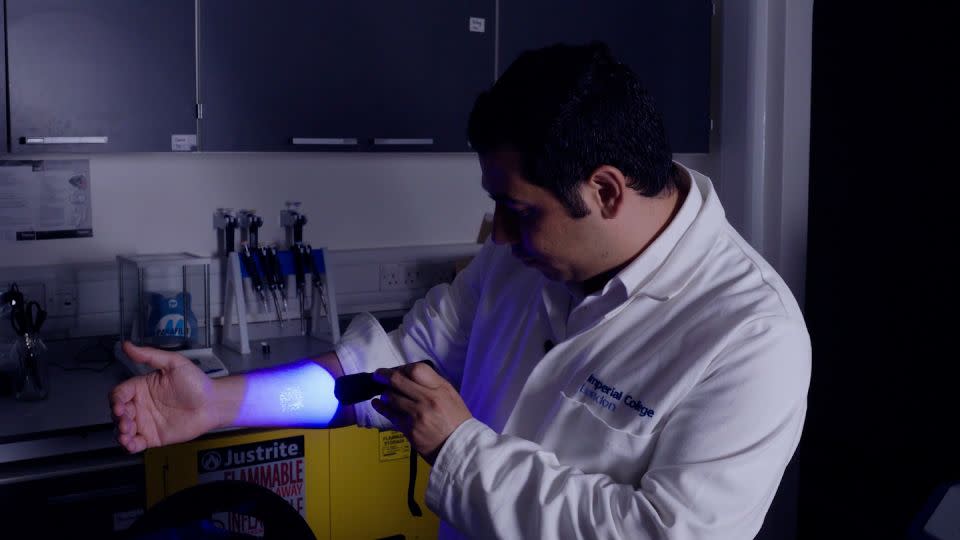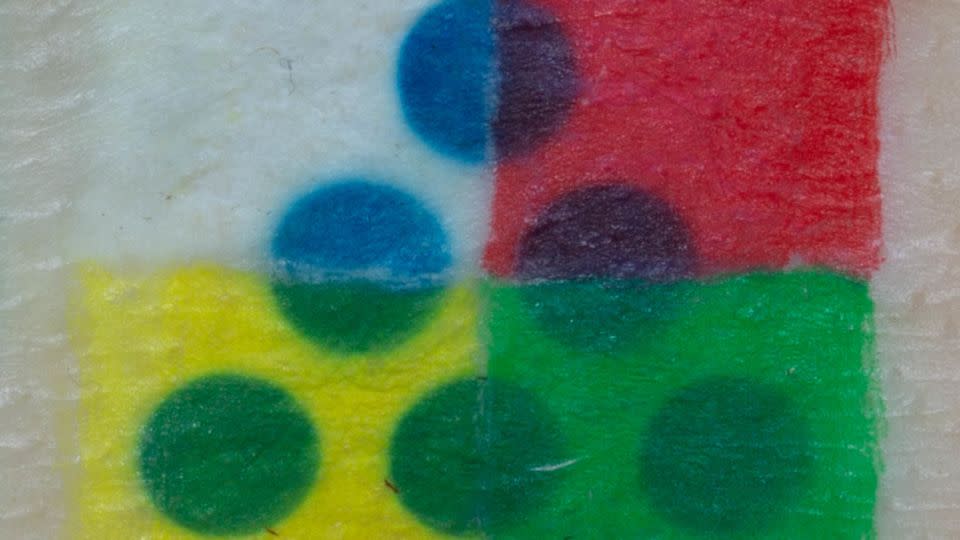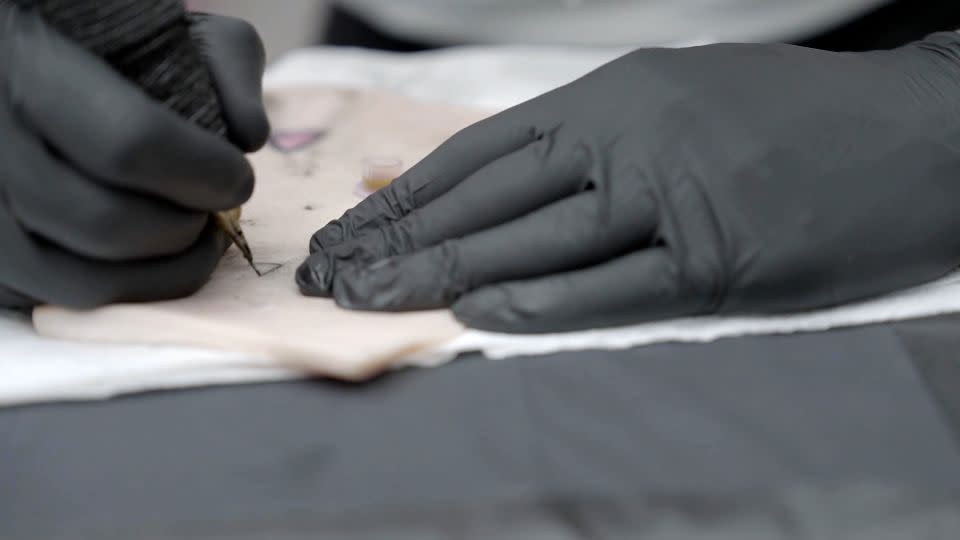Researchers are developing injectable ‘smart tattoos’ that could someday monitor your health
Tattoos are considered to be among the oldest forms of art, dating back thousands of years and practiced by many cultures across human history. Now some researchers believe the next generation of tattoos will be ab out more than just markings – by helping keep tabs on our health.
Creating “smart tattoo” pigments that can be injected under the skin to monitor certain biomarkers in the human body requires a collaboration between “scientists, engineers and designers,” says Dr. Ali Yetisen, a researcher in the Department of Chemical Engineering at Imperial College London.
His concept replaces conventional tattoo ink with “functional materials,” Yetisen says, creating “tattoos that change their color in response to external stimuli,” such as a change in blood sugar levels for people with diabetes, monitoring kidney or liver functions, or warning athletes of dehydration.
Yetisen began his work as a postdoctoral research scientist at Harvard Medical School. Along with fellow Harvard and MIT researchers, he debuted a proof of concept called Dermal Abyss in 2017. Four biosensors changed color in response to “three pieces of biochemical information in body fluid,” including glucose and pH levels, according to MIT.
“We hope that these innovative technologies will be a general platform in order to utilize diagnostic technologies,” Yetisen says, including a “wide range of implantable and injectable sensors that can report and display the human condition in real time.”

Invisible ink
While the work of Yetisen and his team focuses on the body from the inside out, a research lab run by Dr. Carson Bruns is working on smart tattoos to help monitor external factors such as radiation or UV light exposure, a leading cause of skin cancer – “by far the most common type of cancer,” according to the American Cancer Society.
Bruns, an assistant professor of mechanical engineering at the University of Colorado Boulder, says he got his first tattoo at age 19, sparking a love of the art that has carried over into his research. In 2020, he was part of a team that published a paper on a small, light-sensitive tattoo dubbed the “solar freckle” – a “little dot powered by sunshine,” as Bruns describes it. The otherwise invisible tattoo would reveal itself when exposed to UV light, like when a person has been in the sun for too long, and disappear when more sunscreen has been applied or after leaving the sunlight.
Convinced of the safety even before running wider tests (there are no FDA-approved tattoo inks in the US, Bruns says, and his team is using “non-toxic, medical-grade materials that have a long history of biomedical use” for the smart inks), Bruns gave himself several solar freckle tattoos, which lasted roughly six to eight months before fading, he says.

The team has since developed smart tattoo pigments that can work for at least three years, Bruns adds, and can be “turned on and off” by controlling the light source.
The technology is now being commercialized through a new company called Magic Ink, in partnership with Bruns, fellow scientist Jesse Butterfield, and the celebrity tattoo artist known as Bang Bang. There’s interest from tattoo artists for cosmetic reasons and also for potential health uses, primarily in the field of radiation treatment, according to Bruns. Millions of patients undergoing radiation therapy receive small tattoos, which help radiation therapists pinpoint the same location during every treatment. But many patients don’t want the tattoos as a “permanent reminder of a traumatic experience,” he explains.
Instead, using the smart ink, “you can come in and your radiation therapist can shine a little UV light on, you activate the tattoo so it’s visible and they can align the [radiation] beam,” he says, “and then as soon as your radiation therapy is done, they can shine a white light on you and the tattoo will disappear … until the next time you come back for treatment.”
Bruns recently received a National Science Foundation CAREER research award for $605,000, separate from Magic Ink, which he says will fund more research into the overall safety of smart tattoos. “We hope our results will ultimately inform Magic Ink and all tattoo ink manufacturers how to optimize the biocompatibility of their pigments in due time. Magic Ink will likely aim for FDA approval at some point in the future when and if there is finally a precedent for an FDA approval process for tattoo pigments in the United States,” he adds.
A “check-engine light”
Researchers say one advantage of smart tattoos over wearable technology such as smart watches or glucose monitors is that they can’t be hacked or run out of battery.
“Wearables are great,” says Bruns, but they eventually become uncomfortable or need to be replaced over time, and implants often require more invasive surgeries. “(Smart tattoos) are the most convenient,” he believes, “because it’s kind of this wonderful middle ground between wearables and implants.”
According to Dr. Daniel Kraft, founder of NextMed.Health, a platform that brings innovators together to reimagine the future of health care, “smart tattoos are early in their evolution, but as technology accelerates at an exponential pace, they have the potential to play a significant role in health and wellness, especially as technology shrinks and data and insights become more personalized and proactive.”
“Low-cost, temporary health-related tattoos could even play a role in health screening, and in low-resource global health and public health settings,” he added in an email to CNN.
Kraft, who is not involved in Yetisen’s or Bruns’ research, compares smart tattoos like the blood glucose-level monitoring proposed by Yetisen’s London lab to a “check-engine” warning light in a car, which could prompt someone to take action before an issue becomes more serious.
Challenges ahead
But one challenge is getting the general public to accept this technology, agree both Yetisen and Bruns. For some people and cultures, there’s a stigma around having a tattoo, while others have questions about the safety of injections under the skin.

So far, Yetisen’s technology has been tested on pig skin, and human clinical trials will be the focus over the next three years, he says. They are considered medical devices, so it’s unlikely you’ll be able to book an appointment for one at your local tattoo parlor; instead, it would be a hospital setting, he adds, where a dermatologist can inject the tattoo biosensors.
Another challenge will be making sure the data and insights are accurate enough, leading to “meaningful, actionable insights” for disease prevention, diagnosis and therapy, says Kraft, and for all skin types including darker skin colors. He adds that another hurdle to wider public acceptance will be if tattoos must be frequently reapplied, as even traditional tattoos often fade over time.
In its current form, Yetisen’s high-tech ink can only be “utilized from weeks to months, and after a certain period of time, it will be absorbed by the human body,” Yetisen says. His team is working to extend that timeframe, while exploring an idea to use nature-inspired bioluminescent sensors that glow on the skin under a certain light.
He envisions a future where astronauts could utilize smart tattoos in space to gauge radiation exposure, for infectious disease detection in the general public or to help monitor chronic disease.
“I believe that in the next decade, human skin will serve as an interactive display in order to show a wide range of biomarker changes,” Yetisen says.
CNN’s Michelle Cohan contributed to this report.
For more CNN news and newsletters create an account at CNN.com

